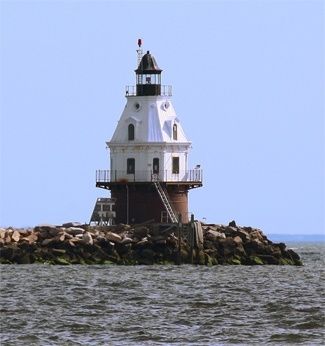By Dan Shine
Voice Columnist

Maritime Series, Part II
See part 1 | part 3 | part 4 | part 5 | part 6 | part 7
New Haven Harbor’s Breakwaters
We look out across the water and there they are; we take them for granted and give them little if any thought. But why are they there? How old are they, and are they really necessary anyway? For most of us the “breakwalls”, or breakwaters as they are more commonly known, are just a pile of rocks that hold back the waves of Long Island Sound. Aside from mariners and pleasure boaters, no one pays any special attention to them. And yet, they are a truly important component in the past and present of New Haven Harbor.
From its earliest days, New Haven has been a significant port city: after Boston and Providence, it is the third largest and busiest in New England. The harbor itself is four miles wide and is a principal reason why New Haven is called “the southern gateway to New England”.
During the 1870s, New Haven Harbor was a busy and exciting place. On a typical day, one hundred sailing ships crowded the docks, as an equal number sat at anchor in the harbor, waiting for a favorable wind and tide. As unreal as it may seem, it has been stated that in 1895, about 31,000 vessels entered New Haven Harbor; of that number, 9,000 were still under sail, and over 8,000 were barges.
History tells us that every ten years or so, severe storms had destroyed large numbers of merchant ships at New Haven’s docks or in the harbor. At the urging of Captain Charles H. Townshend, Yale President Theodore D. Woolsey, Mayor A.B. Bigelow and Thomas Trowbridge, along with interested groups from New York to New London, the construction of protective devices was recommended to Congress. The improved harbor would provide ships with a dependable refuge, and this would stimulate further trade with the port.
As a direct result, the River and Harbor Act of 1879 authorized the construction of two riprap breakwaters (the present east and middle breakers) at the entrance to the harbor to provide this needed shelter.
The work was assigned to the Army Corps of Engineers, and the first two breakwaters were completed in 1894. Those two breakwaters were not fully adequate and two additional breakwaters were authorized to be built. Ultimately, only the present westerly breakwater was completed in 1904, for a total of three. The entire cost of the project was just over $1.2 million.
Each of the three riprap breakers is 1000 yards long, and extends twelve feet above high water level. They are constructed of two-ton slabs of granite that are three feet thick. In all, 1.5 million tons of granite were used to construct the three breakwaters. The granite was most likely quarried in Branford. In this present age of advanced mechanization, we can only wonder at the efforts required to accomplish this task! Out on the Sound, laborers would lower the huge slabs into the thirty foot water, using A-frame hoists. There were plenty of immigrants who worked on this project: Scots, Swedes, and Irish immigrants labored in the quarries; most of the skilled masons were Italians or Cornishmen from England.
The breakwaters were not held together by mortar or cement, but were carefully laid, stone upon stone, to withstand violent wave action and severe storms. And today they still stand–generations later–a silent tribute to the talents, determination and vision of those who saw to their creation and completion.